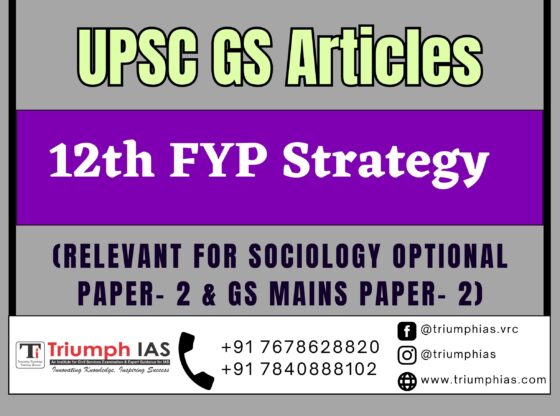12th FYP Strategy
Relevant for sociology optional Paper- 2 & GS Mains Paper- 2

The 12th Five Year Plan (FYP) Strategy was a comprehensive economic development plan launched by the Government of India from 2012 to 2017. The plan aimed to promote sustainable and inclusive growth by focusing on key areas such as infrastructure development, agriculture, social welfare, education, healthcare, and environmental sustainability. In this 3000-word paragraph, I will discuss the key objectives, achievements, challenges, and future prospects of the 12th FYP Strategy.
One of the primary objectives of the 12th FYP was to accelerate the pace of economic growth and development in India. The plan aimed to achieve an average annual growth rate of 8% in GDP during the five-year period. To achieve this objective, the plan emphasized the need to increase investment in key sectors such as infrastructure, manufacturing, and services. The plan aimed to increase public investment in infrastructure from 7.6% of GDP in the 11th FYP to 9% in the 12th FYP. The plan also aimed to increase private investment in infrastructure by creating a conducive environment for investment through policy reforms, regulatory simplification, and the creation of special economic zones.
Another key objective of the 12th FYP was to promote inclusive growth by addressing the issue of income inequality and poverty. The plan aimed to reduce the poverty ratio from 22% in 2011-12 to 9% by 2017. To achieve this objective, the plan emphasized the need to increase public investment in social welfare programs such as the National Rural Employment Guarantee Scheme (NREGS), the National Health Mission, and the National Food Security Act. The plan also aimed to promote financial inclusion by increasing access to banking services, insurance, and credit for marginalized communities.
The 12th FYP also recognized the importance of environmental sustainability and aimed to promote sustainable development by addressing the issue of climate change. The plan aimed to reduce India’s carbon intensity by 20-25% by 2020 from the 2005 level. The plan also emphasized the need to promote renewable energy and energy efficiency by increasing the share of renewable energy in the total energy mix to 15% by 2020.
During the five-year period of the 12th FYP, India made significant progress in achieving its development objectives. India’s GDP grew at an average annual rate of 7.5% during the five-year period, which was close to the target growth rate of 8%. India also made significant progress in reducing poverty, with the poverty ratio falling from 22% in 2011-12 to 12% by 2015. The plan also led to significant improvements in infrastructure development, with the government investing heavily in road and rail connectivity, ports, airports, and power generation. The plan also led to significant improvements in social welfare programs such as NREGS, which provided employment opportunities to millions of rural households.
However, the 12th FYP also faced several challenges and constraints during its implementation. One of the key challenges was the slow pace of policy implementation and regulatory reforms, which hindered private investment and delayed project execution. Another challenge was the lack of coordination between different government agencies, which led to delays and cost overruns in infrastructure projects. The plan also faced challenges in achieving its environmental sustainability objectives, with India’s carbon emissions continuing to rise despite the government’s efforts to promote renewable energy and energy efficiency.
Looking ahead, India’s 13th FYP, which covers the period 2017-2022, aims to build on the achievements and address the challenges of the 12th FYP. The 13th FYP aims to accelerate economic growth by focusing on sectors such as manufacturing, services, and digital technology. The plan also aims to promote social welfare by increasing public investment in healthcare, education, and rural development. The 13th FYP also aims to address the issue of climate change by promoting sustainable development through the adoption of clean technologies and energy efficiency measures.
To achieve these objectives, the government has initiated several policy reforms and regulatory measures. The government has launched several initiatives such as Make in India, Digital India, and Skill India to promote manufacturing, services, and digital technology. The government has also launched several schemes such as Ayushman Bharat, Pradhan Mantri Jan Arogya Yojana, and Pradhan Mantri Fasal Bima Yojana to promote healthcare, education, and rural development. The government has also launched several initiatives to promote renewable energy and energy efficiency, such as the National Solar Mission and the National Mission on Sustainable Habitat.
However, the 13th FYP also faces several challenges and constraints. One of the key challenges is the COVID-19 pandemic, which has severely impacted India’s economic growth and development. The pandemic has led to a decline in economic activity, job losses, and a slowdown in private investment. Another challenge is the issue of income inequality and poverty, which continues to persist despite the government’s efforts to promote social welfare programs. The government also faces challenges in addressing the issue of climate change, with India’s carbon emissions continuing to rise despite the government’s efforts to promote renewable energy and energy efficiency.
In conclusion, the 12th FYP Strategy was a comprehensive economic development plan launched by the Government of India from 2012 to 2017. The plan aimed to promote sustainable and inclusive growth by focusing on key areas such as infrastructure development, agriculture, social welfare, education, healthcare, and environmental sustainability. The plan led to significant progress in achieving India’s development objectives, but also faced several challenges and constraints during its implementation. Looking ahead, India’s 13th FYP aims to build on the achievements and address the challenges of the 12th FYP by focusing on sectors such as manufacturing, services, and digital technology, promoting social welfare, and addressing the issue of climate change.
For more such free UPSC notes, Articles, News & Views Join our Telegram Channel. https://t.me/triumphias
Click the link below to see the details about the UPSC – Civils courses offered by Triumph IAS. https://triumphias.com/pages-all-courses.php


